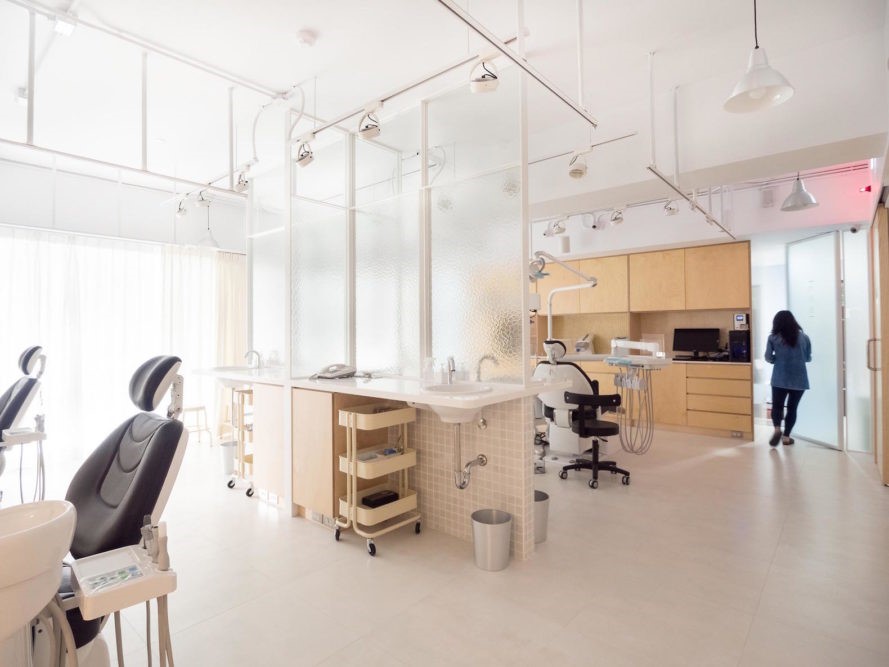When opening a new dental practice, it can feel like there are a million things to plan for and then actually get done.
Not only do you have to make sure that your equipment and staffing needs are met, you also need to secure financing, develop your marketing campaign and business plan, implement dental software and apply for necessary permits and licenses. All of this can make it hard to keep your eye on the big picture – creating a welcoming, streamlined service for your patients.
But when it comes to launching a new practice, ensuring that your clinic is well-designed should be at the top of your checklist for opening. In this article, I’ll explain why.

Good Design Shapes Everything
Design is one of those words that gets used so much and has such a broad definition that it can sometimes lose its meaning. And maybe this isn’t surprising, given that “design” is used to talk about everything from operatory workflow to what kind of light bulbs you use in your reception area.
I find that it is helpful to think about design – whether you’re talking about floor plan, lighting, or dental practice management software – in terms of how it enables you to meet your goals more effectively.
The difference between good design and bad design is specific to what you are trying to accomplish. There is no such thing as “good design” in the abstract: all dental office design should be based on helping you serve your patients better.
What to Consider When Designing a Clinic
So, if design is so important, how can you make sure your new dental practice meets the mark?
There are no one-size-fits all solutions, and what works best for you will depend on a number of different considerations, including:
- The number of staff members you have
- The number of patients you see every day
- Any special equipment you may require
- The physical constraints of your location
- How you prefer to work
- Enabling patient centric workflows
First and foremost, your design should help make your patients feel at ease. Fear of the dentist is one of the most common phobias, and creating a pleasant and comfortable space will go along way toward assuaging patient anxiety.
Here are a few general principles you can keep in mind when designing your clinic space:
- Form should follow function (i.e., layout should reflect the needs of your staff and patients).
- Patient safety should always be a major concern.
- Design should create a sense of trust and comfort.
- Always take your dental software system into consideration when designing floor plans and workstations so you can maximize efficiency and plan appropriately for tech infrastructure.
- Design should reflect your values and priorities. If your clinic serves a particular demographic (e.g. children), that should be reflected in your design decisions!

How to Find a Great Designer
While it is important to do some research into what makes for good clinic design, at the end of the day you shouldn’t expect to be able to do all the design work yourself.
Instead, you should put your energy into finding a dental office designer you can work with, someone who understands your needs and knows how to make your unique vision a reality while also putting their own expertise at your service.
Look for a designer who understands these basic principles of design:
1. Designing with real life in mind
During the design process, ‘space planning’ should come first. This includes defining staff and patient circulation patterns, blocking out important spatial areas, and planning placement of both furniture as well as equipment. Space planning early in the design phase will create efficiency at every iterative step afterward.
2. Have thorough knowledge of materials and construction
The quality of construction and the materials used have a considerable effect on how a patient will experience a finished room. The cost of the materials is not as important as durability. When budgeting, it is prudent to remember that the best materials should keep the space looking fresh for many years.
3. Juxtapose contrasting design elements
By combining different shapes, patterns, and textures, the interplay of one can enhance the innate properties of another. Visual value comes from the interaction of several design principles woven together.
Of course, most designers bring a keen eye, and when designing for a specialty space such as a dental clinic, you’ll need to look out for more than just competence. When looking for a designer, here are some of the most important things to consider:
- Experience in Healthcare: Designing a clinic isn’t like designing a standard office space, so make sure you find someone who understands the unique needs of a dental practice – in particular, functional room requirements and typical procedural workflows
- Ability to Work as Part of a Team: Your designer will have to work closely with equipment specialists, dental planners, and contractors.
- A Safety-Conscious Approach: Over the past few years has been increased attention to the importance of creating a safe environment for dental patients and that also meets requirements for effective infection control. Make sure any designers you opt to work with understand the importance of this, and can incorporate safety features into their plans.
- Long Term Thinking: You want a work space that can change and evolve over time. Make sure you work with a designer who can help you create a dental clinic that can serve your needs and the needs of your patients for years to come.
There’s a popular saying among designers that good design is invisible. If something has been well designed, it will be so intuitive and easy to use that you won’t even think about it. This is definitely true for dental clinics. A clinic where everything is in its right place will provide a comfortable and welcoming space for your patients, and make it easy for you and your staff to focus on what you do best: providing them with the best healthcare possible.



